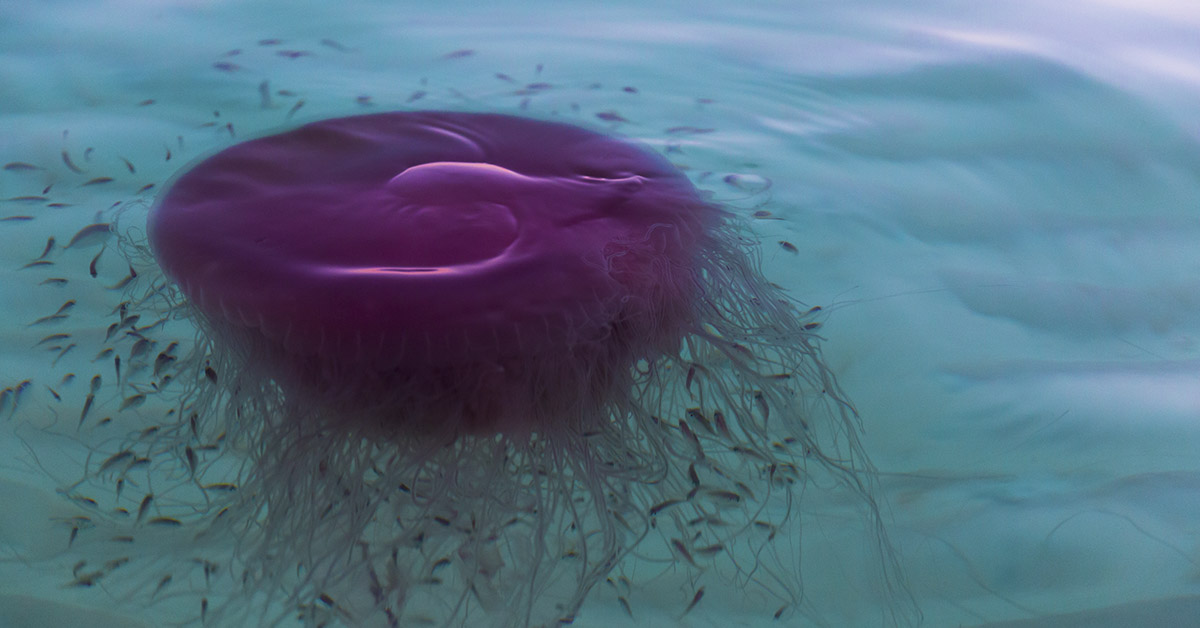Purple flags fly all along the Gulf Coast, from Fort Morgan, Alabama, to Panama City, Florida. Beach officials warn residents of a species of jellyfish called pink meanies. They were initially discovered in the Gulf Coast in 2000, and scientists identified them as a new species in 2011. Pink meanies tend to drift to beaches along the Gulf Coast every 10–12 years; this year they are drawn in by one of their favorite meals: moon jellyfish. In the meantime, beach-goers need to watch their step. [1]
Pink Meanies Appear Along the Gulf Coast
The Drymonema larsoni, commonly known as pink meanies, are a pretty color but they are not to be messed with. They are carnivorous with stinging tentacles that could grow up to 70 feet long. In 2000, a pink meanie found on Dauphin Island weighed upwards of 50 pounds. They are not considered dangerous to people but their sting can become painful.
Escambia County’s Deputy Water Safety Chief Alex Johnson says there have been over 100 sightings of the jellyfish since the beginning of October, although many more could have gone unreported. The stings included in these reports have all been minor. [2]
In 2011, a scientist at the Dauphin Island Sea Lab (DISL) identified pink meanies not just as a new kind of jellyfish but as an entirely new species. Back in 2000, experts found the pink meanies in the Gulf and assumed they were jellyfish native to the Mediterranean. However, after more intensive research, including genetic fingerprinting, they identified them as the unique species of Drymonema larsoni.
Former DISL post-doctoral student Keith Bayha was the one who discovered and named the new species in 2011. He has since worked as a jellyfish research collaborator at the Smithsonian Institute National Museum of Natural History. But in the early 2000s, he was just a graduate student at the University of Delaware. Monty Graham at the DISL had recorded the first sightings of the pink meanies, and he sent samples to the younger Bayha. “I tried to use them for a study I was doing on the Lion’s Mane Jellyfish, whose family the pink meanie previously belonged to, but they were too different,” Bayha explained.
Read: A Talented Photographer Captured the Rare Scene of a Pod of Ten 40 ft Long Sperm Whales Sleeping Vertically
Discovering a New Jellyfish Species
Bayha worked at DISL from 2004 until 2007 but he never saw a pink meanie for himself until he was at the University of California Merced. There, he conducted a study on the evolution on the True Jellyfish (Scyphozoa) marine class, including moon jellyfish, sea nettles, and lion’s mane jellyfish. He also involved pink meanies from the Gulf of Mexico and a Drymonema species he’d found in the coast of Turkey. “In that study, it became clear that Drymonema was a brand new family and very distinct from the Lion’s Mane Jellyfish,” Bayha said.
He co-authored the study with Michael Dawson — a scientist at the University of California Merced Campus who specialized in the history and evolution of marine species. Drymonema’s rarity made it difficult for experts to distinguish them from other jellyfish species. Plus, the uniqueness of jellyfish leaves only subtle differences between different classifications. “Jellyfish are so simple, so there has been this tendency to assume that they are the same everywhere. Like the moon jelly, it was thought to be the same species everywhere around the world. But previous work by Dr. Dawson has shown that there are approximately 13 species,” Bayha said. [3]
Bayha and Dawson described the Drymonema as a new family and dubbed the pink meanies a new species. They named the pink meanies Drymonema larsoni after Ron Larson. “Larson was a colleague and all-around great person who used to collect specimens for the Smithsonian Museum of Natural History and did research on the pink meanie in the Caribbean in the 1970s and 1980s,” Bayha explained. “We also named the Family Drymonematidae, amending the work done by Ernst Haeckel, contemporary of Charles Darwin and famous for his jellyfish illustrations.”
More About The New Species
Pink meanies prey only on other jellyfish, especially moon jellyfish. They entangle their prey in their long tentacles before reeling them in and devouring them. They’ve been documented eating 34 jellyfish at a time. They only live as long as there is enough prey and tend to die when the temperatures become too cold, so their numbers bloom around the late summer/fall when moon jellyfish populations increase. Very young pink meanies eat zooplankton and find shelter under the large bell of the adult pink meanies.
Bayha himself got stung by a pink meanie during his research. Fortunately, his experience was not unbearable. “I had my arm up to the elbow in a really large one we had collected and the sting was minor. My entire arm had a rash the next day, but it wasn’t bad at the time. They eat jellyfish so they don’t need stinging cells full of toxins.” [4]
Keep Reading: Largest freshwater fish ever caught hooked in Cambodia
Sources
- “Pink Meanies, A New Species Of Jellyfish With 70-Foot Tentacles, Washing Up In Florida And Alabama.” Southern Living. Meghan Overdeep. October 8, 2022
- “Purple flags fly over Northwest Florida beaches due to abundance of ‘pink meanies’.” KATV. Kai Davies. October 6, 2022
- “’Pink meanie,’ new species of giant jellyfish, identified in Gulf of Mexico.” Alabama News. Ben Raines. January 12, 2011
- “What is the Pink Meanie? Former DISL post-doc that named it fills us in.” Dauphin Island Sea Lab. October 5, 2022

